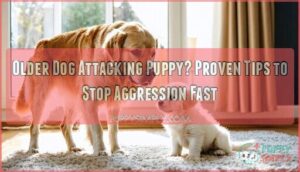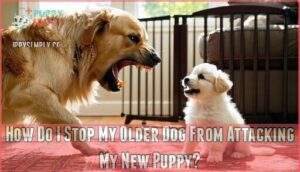This site is supported by our readers. We may earn a commission, at no cost to you, if you purchase through links.
 If your older dog is attacking your puppy, it’s likely frustration, territorial issues, or plain old jealousy at play.
If your older dog is attacking your puppy, it’s likely frustration, territorial issues, or plain old jealousy at play.
Puppies can be like hyper toddlers—too much energy, not enough boundaries—so your older dog might just be overwhelmed.
Start by giving them separate spaces to relax and feel safe. Supervise their interactions closely, and reward calm, polite behavior with treats or praise.
Watch for warning signs like stiff posture or growling. Introducing them too quickly can backfire, so take it slow.
Think of it like roommates adjusting—patience is key. Want more tips to create peace? Let’s calm the chaos together.
Table Of Contents
- Key Takeaways
- Why Does My Older Dog Attack My New Puppy?
- How Can I Help My Dogs Get Along?
- What Should I Do if They’re Not Getting Along?
- How Long Should I Wait for The Older Dog to Get Used to The New Puppy?
- How Do I Stop My Older Dog From Attacking My New Puppy?
- How Do You Introduce a Puppy to an Older Aggressive Dog?
- Can Dogs Live Together After Fighting?
- Frequently Asked Questions (FAQs)
- How do I stop my older dog from being aggressive to my puppy?
- Will an adult dog hurt a puppy?
- What to do if a dog attacks your puppy?
- Why is my dog suddenly attacking my puppy?
- How should I reward positive behavior between my dogs?
- Is it possible to reintroduce dogs after a fight?
- What are the best ways to introduce a puppy to an older dog?
- Can environmental changes trigger conflicts between my dogs?
- How does my older dog’s past experiences affect behavior?
- Are certain dog breeds more prone to conflicts?
- Conclusion
Key Takeaways
- Give your older dog and new puppy separate spaces to reduce stress and avoid conflicts.
- Supervise interactions closely and reward calm, polite behavior with treats to encourage positive associations.
- Introduce them gradually in neutral areas, and use scent swapping to help them get familiar with each other.
- Watch body language for warning signs like stiff posture or growling and intervene calmly to prevent escalation.
Why Does My Older Dog Attack My New Puppy?
It’s frustrating when your older dog lashes out at your puppy, but it’s often their way of setting boundaries.
Older dogs lashing out at puppies often signals their need to set boundaries and establish personal space.
Whether it’s about guarding their space, feeling overlooked, or getting annoyed by puppy antics, understanding why it happens is the first step to fixing it.
Territorial
Territorial behavior in dogs can quickly stir up trouble. Your older dog might see the new puppy as an intruder, triggering dog aggression.
To ease tension, create safe zones where each dog feels secure. Introduce their scents first—swap blankets or toys to help them get familiar.
Start interactions in neutral territory, like a park, to minimize dog territoriality. Watch body language closely for signs of stress or comfort.
Reward calm behavior and respect for space boundaries with treats. Prevent resource guarding by separating toys and feeding areas.
Missing Attention
It’s common for an older dog attacking a puppy to stem from jealousy or missing attention.
Your older pup might feel displaced, leading to resource competition or frustration.
To ease tensions, try these reassurance methods:
- Separate attention: Spend one-on-one time with your older dog to prevent feelings of favoritism.
- Avoid triggers: Watch for attention-seeking behaviors and redirect focus with praise or play.
- Reward calmness: Use treats to reinforce moments when they’re relaxed around the puppy.
Patience and consistency help prevent dog jealousy and build harmony over time.
Provocation
Sometimes, older dog aggression stems from their patience being tested by a puppy’s pestering or boundary violations.
Older dogs often react out of frustration when puppies test their patience with boundless energy and constant boundary-pushing.
Puppies don’t mean harm but can unknowingly provoke frustration with hyperactivity triggers like nipping or constant jumping. Misinterpreted signals, like playful growls or bouncy behavior, may escalate tensions.
To calm things down, supervise interactions closely and redirect energy levels with toys or training. Teach the puppy to respect the older dog’s space using positive reinforcement.
Proper socialization can help curb unwanted behaviors.
By setting boundaries early, you’ll foster cooperation and avoid the older dog attacking the puppy.
How Can I Help My Dogs Get Along?
Helping your dogs get along takes patience, consistency, and a few smart strategies.
By managing their interactions and setting boundaries, you can create a peaceful home where both pets feel comfortable.
Introduce Them Properly
When introducing dogs, set the stage for success by starting in neutral territory.
Follow these steps for a smoother puppy introduction:
- Begin with scent swapping—exchange blankets or toys to familiarize each dog.
- Use leashed introductions in a calm environment for control and safety.
- Rely on gradual exposure, letting them see each other briefly before longer face-to-face meetings.
- Provide supervised meetings to prevent the older dog attacking the puppy.
- Always reward good behavior with treats and praise to build positive associations.
Stay patient—it takes time!
Watch Body Language
Your dog’s body language says it all—like reading subtitles in a foreign film. A stiff posture or focused stare can signal trouble, while relaxed posture and tail wags spell peace.
Watch for bared teeth and tense standoffs. Here’s a quick guide:
Behavior
**Aggression?
| ** | What to Do | |
|---|---|---|
| Relaxed posture | No | Praise with treats |
| Stiff posture, stare | Yes | Separate calmly |
| Tail wags, sniffing | No | Encourage interaction |
Understanding these cues can stop older dog attacking puppy moments before they escalate!
Separate Areas
If your older dog is attacking your puppy, setting up separate areas can help ease tensions.
Dogs thrive on routine and personal space, so create puppy-free zones where each dog can relax.
Here’s how:
- Use baby gates to establish retreat safety for your older dog.
- Rotate dogs between separate rooms to reduce stress.
- Feed them in different areas to avoid food disputes.
- Keep toys managed by limiting access during shared time.
- Try a dog crate for secure downtime.
Rottweilers, for example, need proper socialization techniques to get along with other animals.
Boundaries bring peace!
Reward With Treats
Using treats smartly can create a positive association between your older dog and the puppy.
Focus on consistent reinforcement—reward calm behaviors immediately. Timing matters! Give high-value dog treats during peaceful interactions or when they’re in the same room. Consider using preferred training incentives for best results.
Place rewards strategically to maintain a value hierarchy.
| Tip | Why It Works |
|---|---|
| Use high-value treats | Encourages desired behavior |
| Reward calmness | Reinforces relaxation |
| Place treats separately | Prevents competition |
| Reward the older dog | Builds trust and positive reinforcement |
| Time rewards well | Links treats to good moments |
Stay patient!
What Should I Do if They’re Not Getting Along?
Sometimes, despite your best efforts, your older dog and new puppy just won’t see eye to eye. It’s frustrating, but handling it the right way can make a difference.
Start by keeping interactions short and heavily supervised, focusing on spotting and addressing early signs of dog aggression, like growling or stiff body language.
Here’s what to do:
- Supervise constantly: Never leave them alone together if tension exists.
- Seek professional help: Consult a vet or animal behaviorist for customized strategies.
- Consider re-homing: If aggression escalates or safety is an issue, explore if separations might be best for both dogs.
Understanding dog behaviorist costs can help you budget for professional intervention.
Manage expectations and prioritize safety.
Some dogs simply prefer their space over new companionship.
How Long Should I Wait for The Older Dog to Get Used to The New Puppy?
Getting your older dog used to a new puppy takes time.
The adjustment period varies, so set realistic expectations and be patient. Some dogs need just a few days, while others take months to feel comfortable. Watch for signs of progress, like calmer interactions and less tension.
Here are five tips to manage the gradual adjustment:
- Start slow: Introduce them in a neutral space to reduce stress.
- Supervise closely: Monitor interactions for any signs of discomfort.
- Give breaks: Create separate areas where each dog can relax.
- Encourage positivity: Reward calm, friendly behavior with treats and praise.
- Seek help: If issues persist, consult a trainer to guide the introduction process.
Patience is key—rushing could damage their potential for peaceful coexistence.
You might also consider dog anxiety solutions to ease the process.
How Do I Stop My Older Dog From Attacking My New Puppy?
Dealing with an older dog attacking your new puppy can be stressful, but you’ve got options to regain peace.
Start by ensuring safety—separate the dogs immediately if aggression flares. Often, attacks stem from jealousy, territorial instincts, or confusion about hierarchy. It’s your job to manage this with structure and patience.
Here’s a plan to stop the aggression:
- Use Muzzle Training: Condition your older dog to wear a well-fitted muzzle during interactions to prevent injuries.
- Rule Out Medical Issues: Pain or discomfort could be driving their aggression. Have a vet check your dog.
- Professional Evaluation: A trainer or behaviorist can evaluate and tailor a solution for dog socialization issues.
- Consider Re-Homing the Puppy: If adolescent aggression or frequent attacks persist, relocating the puppy might be the safest option.
With consistency and calm, things usually improve.
How Do You Introduce a Puppy to an Older Aggressive Dog?
Introducing a puppy to an older aggressive dog can feel like walking on a tightrope, but with the right strategy, it’s doable.
Start by easing into things with scent familiarization—swap blankets or toys so they recognize each other’s smell. Choose neutral territory, like a park, for initial meetings to avoid turf wars. Keep both dogs leashed during these introductions for safety and control. Short sessions work best; don’t rush the process.
Pay close attention to body language—relaxed tails and sniffing are great signs. Use positive reinforcement to reward calm, friendly behavior. Treats go a long way in building trust!
One potential cause of aggression is resource guarding behavior.
- Swap scents before introductions.
- Begin in neutral areas.
- Keep interactions brief initially.
- Monitor body language closely.
- Reward calm behaviors generously.
Can Dogs Live Together After Fighting?
After a dog fight, reintroduction strategies can help rebuild trust.
Start slow—use leashes, keep them calm, and reward peaceful behavior with treats.
Muzzle training may add safety during early interactions.
Observe body language closely for aggression signs like stiff posture or a focused stare.
Professional intervention is valuable if fights escalate or harmony seems out of reach.
Remember, dogs don’t hold grudges, and coexistence potential is high when you set boundaries, stay consistent, and prioritize long-term safety in your multidog household.
Frequently Asked Questions (FAQs)
How do I stop my older dog from being aggressive to my puppy?
Create space for your older dog to escape puppy chaos.
Supervise interactions, rewarding calm behavior.
Use leashes during introductions, and teach boundaries with gentle corrections.
Consistent training, patience, and treats can help mend the tension.
Will an adult dog hurt a puppy?
Puppies push patience with their boundless energy, and adult dogs might nip or growl if overwhelmed.
However, true harm usually stems from fear or frustration.
Supervise interactions, respect boundaries, and make certain calm, gradual introductions for safety.
What to do if a dog attacks your puppy?
Stay calm, separate them safely to prevent injuries.
Check your puppy for wounds—clean and treat if needed.
Avoid punishment; instead, assess triggers and supervise future interactions.
If the aggression continues, consult a professional trainer or vet.
Why is my dog suddenly attacking my puppy?
Sometimes, the sweetest dog turns into a grump—it’s often jealousy, territory, or feeling overwhelmed by the puppy’s energy.
Watch for triggers, set boundaries, and help them adjust with patience and positive reinforcement.
How should I reward positive behavior between my dogs?
Reward positive behavior with treats, praise, or gentle petting when both dogs interact calmly or show good manners.
Use a cheerful tone, like you’re celebrating, so they associate cooperation with happiness and yummy rewards!
Is it possible to reintroduce dogs after a fight?
Yes, you can reintroduce dogs after a fight, but do it gradually.
Keep interactions brief, in neutral areas, and supervised.
Use rewards for calm behavior, and don’t rush—patience and consistency are your best tools.
What are the best ways to introduce a puppy to an older dog?
Think of introductions like a first date—set them up for success.
Use a neutral space, keep leashes handy, and let them sniff at their own pace.
Baby gates and treats can work wonders for harmony.
Can environmental changes trigger conflicts between my dogs?
Big changes, like moving, new people, or rearranging furniture, can rattle your dogs.
They thrive on routine. When things shift, they might bicker more, feeling uneasy.
Stick to schedules and create calm, predictable spaces.
How does my older dog’s past experiences affect behavior?
Did you know 70% of learned behaviors in dogs stem from past experiences?
Your dog’s history shapes how they react—trauma, neglect, or lack of socialization can trigger fear or aggression.
Patience and understanding work wonders!
Are certain dog breeds more prone to conflicts?
Some dog breeds, like terriers or herding breeds, may be more prone to conflicts due to high energy or strong territorial instincts.
But remember, personality and training matter more than breed in terms of harmony.
Conclusion
Solving the challenge of an older dog attacking your puppy can feel overwhelming, but it’s manageable with patience and structure.
Start by creating safe spaces and setting clear boundaries. Take introductions slowly, watch body language, and reward positive interactions.
Remember, your older dog isn’t being mean—they’re adapting. With consistency and time, you’ll foster peace between them.
Think of it as guiding siblings to get along. Stay calm, stay committed, and soon they’ll be buddies—or at least truce makers!














